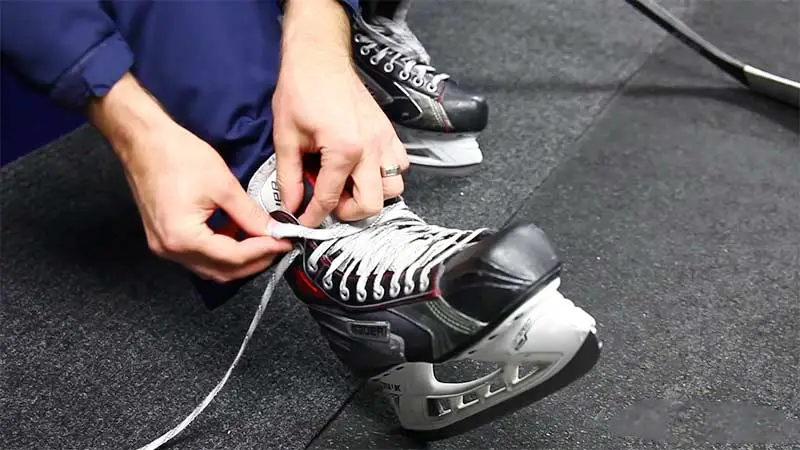When it comes to optimizing your performance on the ice, having the right equipment is key. One crucial but often overlooked component is the length of your hockey skate laces.
Understanding the proper lace length tailored to your skate size can make a significant difference in your comfort and performance on the rink.
Navigating the world of hockey skate laces can be a daunting task, but fear not. With a sizing chart designed to simplify the process, finding the ideal lace length for your specific skate size has never been easier.
Whether you’re a Youth 8 or an Adult 12, this comprehensive guide will ensure that you lace up with confidence and precision every time you hit the ice.
Discovering the perfect fit for your hockey skate laces is not just about aesthetics; it’s about functionality and comfort. Stay tuned to explore the various lacing styles and find the one that suits your game best.
Understanding Hockey Skate Lace Lengths
Why Lace Length Matters
Ensuring the correct length of hockey skate laces is crucial for both comfort and performance on the ice. Properly fitting laces can prevent discomfort, blisters, and even injuries by providing the necessary support and stability to the skater’s feet and ankles.
Laces that are too long can result in excess material that may cause tripping hazards or discomfort, while laces that are too short can restrict movement and lead to an improper fit.
Lace Length Chart Explained
The hockey skate lace length chart serves as a valuable reference tool to help players determine the appropriate lace size based on their skate size.
By matching the skate size to the recommended lace length, players can ensure that their laces provide the right amount of tension and support for an optimal skating experience.
It is essential to refer to the chart to find the perfect balance between a snug fit and comfortable feel while lacing up for the game.
Types of Hockey Skate Laces

Waxed vs Non-Waxed Laces
When considering hockey skate laces, one important distinction to be made is between waxed and non-waxed laces. Waxed laces are coated with wax, providing a grippy texture that helps them stay tight and secure during play.
On the other hand, non-waxed laces lack this coating and are usually preferred by players who want a looser fit or easier adjustability.
The choice between waxed and non-waxed laces ultimately comes down to personal preference and the desired level of tightness and security needed during gameplay.
Color and Design Options
Hockey skate laces come in a variety of colors and designs, allowing players to personalize their skates and match their team colors or personal style.
From classic solid colors to neon hues, there is a wide range of options to choose from. Some laces even feature patterns or designs that add a unique touch to the skates.
When selecting laces based on color and design, it’s essential to consider factors like visibility on the ice, team uniform requirements, and personal style preferences to find the perfect match for both aesthetics and function.
Hockey Skate Lace Length & Sizing Chart
Hockey skate lace length can vary depending on the size of the skate and the lacing pattern you prefer. Here’s a general guideline:
- Youth (Y) skates: 72″ – 84″ (182 cm – 213 cm)
- Junior (JR) skates: 84″ – 96″ (213 cm – 244 cm)
- Senior (SR) skates: 96″ – 120″ (244 cm – 305 cm)
For sizing, you can use the following chart as a reference:
- Youth (Y) sizes: Typically range from 6Y to 13Y.
- Junior (JR) sizes: Typically range from 1 to 5.
- Senior (SR) sizes: Typically range from 6 to 15.
Choosing the Right Length for Your Skates

Lace Length by Skate Size
When it comes to determining the appropriate length of hockey skate laces, referencing a sizing chart based on your skate size is crucial.
The lace length can vary depending on whether you have youth, junior, or adult skates. For example, youth skate sizes usually require lace lengths ranging from 72 to 84, while adult skate sizes typically need longer laces, ranging from 96 to 130.
By matching your skate size to the corresponding lace length on the chart, you can ensure proper fit and comfort during your time on the ice.
Adjusting for Lacing Techniques
Once you have the right length of hockey skate laces based on your skate size, it’s essential to consider different lacing techniques that may impact the required lace length.
For example, if you prefer a tighter fit or use specific lacing methods like the Under Criss Cross Lacing, you might need slightly longer laces to accommodate the desired style.
On the contrary, if you find that the laces are too long after lacing up your skates with a particular technique, you can always adjust by choosing a shorter lace length for a better fit.
Experimenting with various lacing techniques and lace lengths can help you customize your skates for optimal performance and comfort on the ice.
How to Lace Your Hockey Skates Properly?
Sure, here’s a step-by-step guide on how to lace your hockey skates properly:
Standard Criss-Cross Lacing
Lacing your hockey skates in a standard criss-cross pattern is a fundamental technique that provides stability and support. Start by threading the lace through the bottom eyelets, ensuring equal lengths on both sides.
Cross the laces over, pulling them tight to secure the skates but not too tight to restrict movement.
Continue criss-crossing up the skate, gradually tightening as you go. Finally, loop the lace around the last eyelet or notch at the top to lock the laces in place.
Alternative Lacing Techniques
In addition to the standard criss-cross method, there are various alternative lacing techniques that can offer unique benefits.
For instance, the “loopback” technique involves creating a loop with the lace and threading the lace through it to provide a more customized fit around the ankle.
Another technique, called “bar lacing,” focuses on tightening specific areas of the skate where additional support is needed.
Experiment with these alternative methods to find the one that best suits your comfort and performance needs on the ice.
Maintaining Your Skate Laces
Maintaining your skate laces can extend their lifespan and ensure optimal performance. Here are some tips for keeping your skate laces in good condition:
Tips for Lace Care and Longevity
To ensure your skate laces last longer and maintain their performance, it’s crucial to implement proper care practices. Here are some essential tips for maintaining your skate laces:
Regular Cleaning
Dirt, grime, and moisture can deteriorate the quality of your laces over time. Clean your laces regularly by handwashing them with mild detergent and letting them air dry.
Avoiding Over-tightening
While it’s essential to have a snug fit, over-tightening your laces can put excessive strain on them, leading to premature wear and tear. Lace your skates securely without putting too much pressure on the laces.
Inspecting for Damage
Routinely check your skate laces for any signs of fraying, thinning, or damage. Replace laces that show these indications to prevent unexpected breakage during skating.
Proper Storage
When not in use, store your skates in a cool, dry place to prevent the laces from being exposed to harsh elements that could weaken them.
Trimming Excess Length
If your laces are too long, consider trimming the excess length to prevent them from dragging on the ice or getting caught in the skate components.
By following these care tips, you can extend the lifespan of your skate laces and ensure optimal performance on the ice.
When to Replace Your Laces?
Knowing when to replace your skate laces is essential to maintain safety and performance. Here are some indicators that it’s time to invest in a new pair of laces:
Visible Wear
If you notice significant fraying, thinning, or visible signs of wear on your laces, it’s time to replace them as compromised laces can affect the stability of your skates.
Loss of Grip
Worn-out laces may lose their ability to stay securely tied or grip the eyelets properly, resulting in frequent loosening during skating sessions.
Reduced Performance
If you find yourself constantly readjusting or retying your laces on the ice, it could be a sign that they have worn out and need replacement.
Unexpected Breakage
Sudden breakage of laces while skating can be dangerous. If your laces break unexpectedly, replace them immediately to avoid any accidents.
Regularly inspecting your skate laces for these signs and proactively replacing them when needed will help you maintain safe and enjoyable skating experiences.
Frequently Asked Questions
How to select the correct hockey skate lace length for comfort and performance?
Choose a lace length based on your skate fit and lacing style. Measure your old lace for reference. Opt for shorter or longer laces as per personal preference.
What are the differences between waxed and non-waxed hockey skate laces?
Waxed laces are stiffer and less prone to stretching, providing better grip and maintaining tightness. Non-waxed laces are softer and easier to tighten but may require frequent adjustments.
What are common lacing techniques for hockey skates?
Popular lacing techniques include criss-cross, loopback, and bar lacing styles. Experiment to find the one that offers the best support and stability for your feet.
How to care for and maintain hockey skate laces?
To prolong the lifespan of skate laces, clean them regularly, avoid over-tightening, inspect for damage, store properly, and trim excess length as needed.
When should you replace hockey skate laces?
Replace laces when they show visible wear, lose grip, impact performance, or unexpectedly break. Regularly inspect your laces and have a spare pair ready for quick replacement.
Conclusion
Choosing the right hockey skate lace length is crucial for comfort and performance. Understanding the differences between waxed and non-waxed laces, along with various customization options, can greatly impact your skating experience.
Proper lacing techniques, such as criss-cross and loopback, provide the stability and support needed on the ice.
Maintaining your skate laces through proper care, inspection, and timely replacement is essential to ensure optimal performance and safety.
By following these guidelines, you can enhance your skating experience and prolong the lifespan of your hockey skate laces.








Benjamin Kenyon